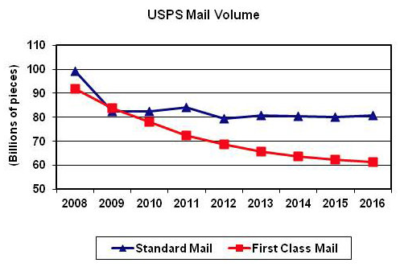Once upon a time direct mail was king. Then the Great Recession hit in 2008, causing many companies to significantly reduce marketing budgets. With the advent of the Internet and digital marketing channels, these lower costs channels started to dominate. Direct mail was slashed heavily, and in many cases abandoned entirely. Direct mail was declared dead by many and the Internet reigned supreme. But is direct mail really dead?
While the overall volume of direct mail is surely down compared to pre-recession levels, the USPS reports that it has steadily (since 2009) delivered 80 billion pieces of standard class direct mail each year. And as the volume of transactional first class mail (e.g. bills and statements) continues to decline, that means there’s less competition in the mailbox. This evidence clearly suggests that direct mail is not dead, but instead is alive and thriving!

Direct Mail Works
While digital marketing continues to be a primary focus for many companies, savvy multi-channel marketers have proven that direct mail can be a very effective part of the overall marketing mix – how else can you explain 80 billion pieces per year?
It’s really fairly simple: For companies looking to grow, digital marketing can typically only take them so far. Moreover, the ROI of digital investments on the margins may be quite low (e.g. portions of Non Brand PPC) – and in some cases is very difficult to measure at all (e.g. display). As a result, marketers continue to invest in direct mail – the ROI can be very high and it helps them meet their growth objectives.
Here are some other compelling advantages of direct mail compared to digital:
- Direct mail is tangible – it can be retained by the recipient for a long time, given to others and is a key element for branding
- Direct mail is more effective in driving calls-to-action
- Direct mail is highly trackable and measurable
5 Keys to Direct Mail Success
Marketers can establish and scale a successful direct mail programs by focusing on 5 key factors:
- Targeting: The audience you mail to is by far the most important factor in direct mail, and in today’s data-rich environment there are many new ways to target the consumers or businesses most likely to respond and buy. Many mailers start by testing rented lists with characteristics that match their target audience – for example magazine subscribers (e.g. Runners World) or lists developed based on transactional behavior (e.g. recently purchased hair care products). Financial institutions use credit data extensively to source prospects. And in this age of Big Data, there’s never been more options to efficiently append a variety of additional data attributes to prospect lists, ranging from traditional demographics to the emerging new class of online digital behavior. Mail selections can then be tested and refined using this data – either via simple segmentation or more sophisticated predictive modeling. Get the targeting right and you’re well on your way to having a successful direct mail program.
- Great Creative & Compelling Offers: Consumers are most likely to respond to packages that stand out in the mail with compelling design and offers, and with messaging and calls-to-action that are easy to understand. One key challenge for every company is attaining the right balance between being “true to the brand” and maximizing response rate – those two goals sometimes conflict.
- Continual Testing: Successful direct mailers are always testing against their control position, whether it be creative, offers, lists, calls-to-action, response channel options, etc. Testing generates the insights required for program optimization – the winning tests become the new control.
- Analytics: Data analysis is key to optimizing direct mail. The goal is to analyze campaign results immediately to understand the performance of creative, offer and list tests. While basic reports will typically provide the results of tests, great direct mailers will also do deep-dive analysis of data sets to develop additional insights to drive future marketing.
- Cost Control: While mail is a relatively expensive impression (but high response rate compared to digital), tight program management can reduce costs and improve ROI. Once a program is established, there are many opportunities with suppliers (e.g. list owners, list processors, letter shops) to negotiate pricing. You can test “cost save” versions of control packages – for example can you maintain response while reducing the package size or eliminating an insert? When campaigns are large enough there are ways to reduce postage costs. Great direct mailers (and marketers in general) are always reducing cost wherever possible.
Is Direct Mail Right for Your Business?
If you’re not mailing today, consider testing the channel to see if it will work for your business.
- For companies that mailed in the past but stopped, so much has changed in recent years, especially with targeting options in the era of Big Data.
- For companies that have never mailed, especially those that started in the Internet age, you might be very surprised at how mail can help you grow.
If you’re mailing today but not happy with the results, review your targeting, creative and your partners to see if the problem isn’t with the channel but with one of these three areas.
Want to Learn More About How Direct Mail Can Help Your Business Grow?
DIRECTed Consulting can help you understand your options and develop a strategy that’s right for your business – please contact us today for a free consultation.

